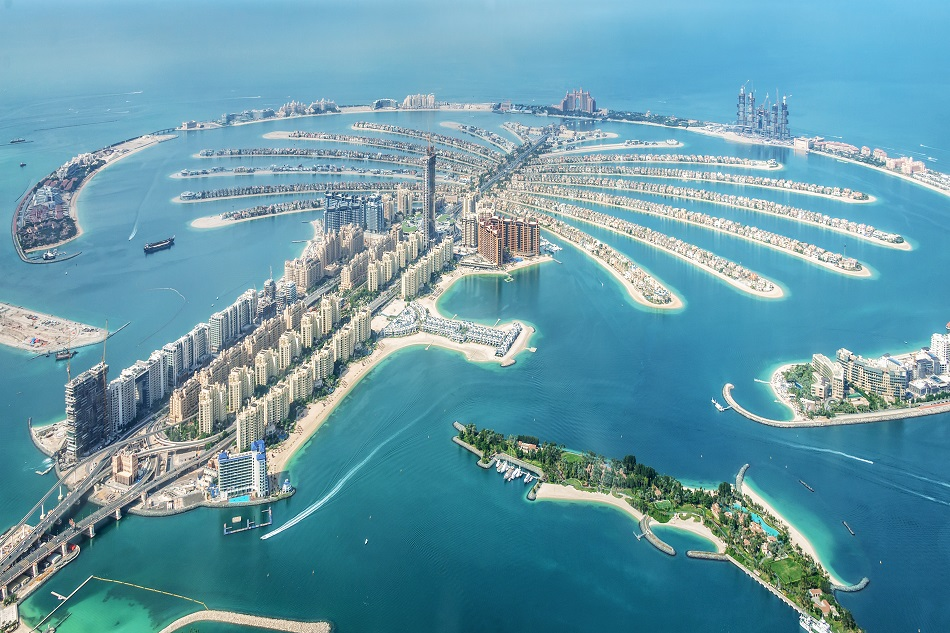What Materials Were Used to Construct the Palm Islands?

Epitome Credit: Delpixel/Shutterstock.com
The Palm Jumeirah is an artificial archipelago in Dubai. Construction began in 2001 and the first residential units were handed over in 2006. Information technology was created through a range of innovative engineering techniques to 'reclaim' habitable land from the sea. It is one of iii man-made islands known collectively equally the Palm Islands. These artificial islands extend into the Persian Gulf and increased Dubai's shoreline by a full of 520 km (320 mi).
The Palm Jumeirah is the smallest of the 3 islands developed by Nakheel, 1 of the world's largest state-owned existent estate developers. It is located on the Jumeirah littoral area of the emirate of Dubai, in the United Arab Emirates (UAE).
Designing the Palm Jumeirah
The Palm Jumeirah was designed and adult by the US architectural firm Helman Hurley Charvat Peacock. The palm shape was called as a tribute to the national tree of UAE – the date palm tree, often referred to as the 'bride of orchard'. Its geometric pattern also creates maximum beach frontage.
The Palm Jumeirah consists of elements including a trunk, a crown with 17 fronds, and a surrounding crescent isle that forms an 11 km long breakwater to protect the structure from air current and moving ridge erosion and long-shore drift. The crown is connected to the mainland past a 300-m bridge, while the crescent is continued to the top of the palm by a sub-sea tunnel. In total information technology covers 560 ha of land created through country reclamation.
PALM JUMEIRAH ATLANTIS MAKING DUBAI
The isle helps stimulate marine life by using food-rich materials and a sub-ocean structure designed to assist biodiversity. Two independent oceanographic experts from California, Professor Joseph Valencic and Jim Miller, were invited to research the bounding main life effectually the location of The Palm Jumeirah earlier, during and after reclamation.
Over 100 studies relating to transportation, marina design, water supply, technology, and civil works were conducted to assess and ensure The Palm's feasibility and long-term viability.
Construction of the Palm Jumeirah
Construction of the Palm Jumeirah began in 2001 when state reclamation commenced. The island required 94,000,000 m3 (3.three×109 ftthree) of sand and 7 1000000 tonnes of rock. The Palm Jumeirah was created past pouring/depositing dredged sand onto specific locations in the 10.5 1000-deep seabed using dredgers. This process was handled by the Belgian company, Jan De Nul and the Dutch company Van Oord. The sand was sprayed past dredging ships guided by DGPS, onto the required area in a process known as pelting-bowing. Calcareous sand was mainly used for the reclamation.
The chief idea backside constructing the curved rock breakwater or 'Crescent' was to withstand a 4m tidal wave (a potential risk in this expanse in winter) and to promote a natural reef system to increase biodiversity around the Palm. The Crescent is built from the bottom up with first sand, then geotextile fiber, followed past small rocks, and and then medium-sized rocks. Divers were employed to examine the placement of rocks underwater to ensure correct positioning.
Artful Components of the Palm Jumeirah
Apart from the shape of the Palm Jumeirah, the island has over 12,000 Palm trees that were initially grown in a nursery in Jumeirah, Dubai. The Arabian Gulf is rich in marine life from varieties of shellfish to corals, crabs, and fish. 2 F-100 Super Sabre fighter jets were stripped and sunk nearly the Palm Jumeirah to create an artificial reef to promote marine life which likewise acts as an underwater attraction for recreational divers.
Accommodation and Facilities in the Palm Jumeirah
The Palm Jumeirah is a world-famous residential, tourism and leisure destination. The 3 principal areas in this isle are the trunk, crescent, and the fronds. The fronds form the head of the Palm Jumeirah and house several luxury beachfront villas. The entire construction is designed for almost 8000 permanent and temporary residents.
The Palm Golden Mile is a strip of land located along the center of the body. It officially opened in 2008 and is habitation to the Shoreline Apartments, which are a range of standard and luxury apartments, penthouses, and townhomes.
A vi-lane sub-sea tunnel connects the trunk to the crescent. The tunnel is one.4 km long, 40m wide and 25m below body of water level. There is a 5.four km (iii.4 mi) monorail called the Palm Jumeirah Monorail connecting the Atlantis Hotel to the Gateway Towers at the foot of the isle. The Monorail has been operational since May 2009. There are iii stations on the monorail.
Interesting Facts about Palm Jumeirah
The following are some interesting facts of the Palm Jumeirah:
- The Palm Jumeirah is a man-made construction that can be viewed from infinite with the naked eye.
- The commencement phase of residential complexes at the Palm Jumeirah was ready at the end of 2006. It is reported that all 4000 kickoff stage properties sold out within 72 hours of the initial sales release.
- The Palm Jumeirah is abode to more than 70 different nationalities.
- Reports country that if all of the materials used to build one of the Palm Islands were placed end to end, a wall 2m high and one-half a meter thick could circle the world three times.
- It is claimed that more than 800 football pitches can be fitted into the Palm Jumeirah.
Sources and Further Reading
- The Palm Jumeirah: background - zawya
- The Palm Jumeirah-dubai.travel - culture
- Nakheel announces AED2 billion profit for 2012 - nakheel
This commodity was updated on viith February, 2020.
Source: https://www.azobuild.com/article.aspx?ArticleID=8135
0 Response to "What Materials Were Used to Construct the Palm Islands?"
Post a Comment